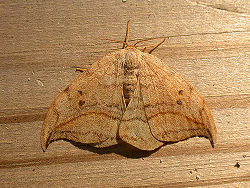| Dusky hook-tip | |
|---|---|
 | |
| Scientific classification | |
| Kingdom: | Animalia |
| Phylum: | Arthropoda |
| Class: | Insecta |
| Order: | Lepidoptera |
| Family: | Drepanidae |
| Genus: | Drepana |
| Species: | D. curvatula |
| Binomial name | |
| Drepana curvatula (Borkhausen, 1790) | |
| Synonyms | |
| |
Drepana curvatula, the dusky hook-tip, is a moth of the family Drepanidae. [1] It was first described by Moritz Balthasar Borkhausen in 1790 and it is found from Europe to Japan.
Contents
The wingspan is 34–42 mm. The moth flies from May to August depending on the location.
The larvae feed on alder, oak and birch.
